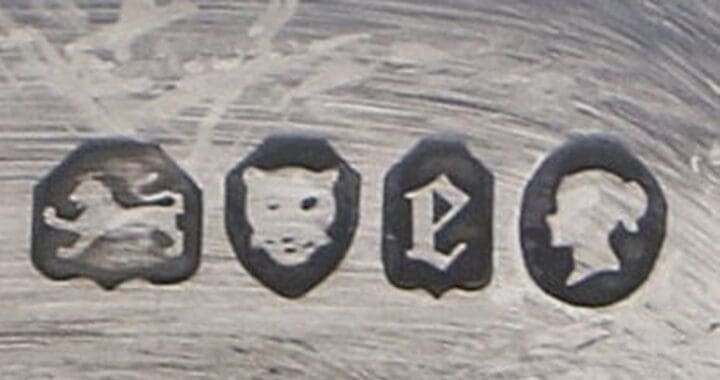Jenny Knott, Silver and Jewellery Specialist
Download this article
Hallmarking is one of the oldest forms of consumer protection. It dates back to 1300 when Edward 1st instituted a statute for the assaying or testing of precious metals. The purpose of this was to make sure that silver in production for domestic use would have the same fineness as that of coin silver. The standard of silver was therefore set as the same as that of coinage. This is ‘sterling’ silver and denotes silver in which pure silver makes up at least 92.5% of the content, the rest being alloy. This alloy is necessary to make pure silver, which is soft and malleable, into silver that is more user friendly, but still attractive and workable.

The hallmark for Paul Storr. London 1810
There is a theory that the term ’sterling’ comes from the word Easterlings – who were people experienced in coin making, from the Eastern German states brought to England in the reign of Henry II to improve the quality of the coinage.
The original statute allowed wardens from the Company of Goldsmiths in London to circulate around the workshops in the city and test the silver and gold. At that time, silver was assayed and marked with the lion’s head, which is still the symbol of the London assay office today. The term for a lion at the time was ‘leopart’ and so it became known as a leopard’s head, though as you can see from the images it is a lion.
Gradually gold too came to be assayed and bore the same leopard’s head mark. In 1363, the maker’s mark started to be added. Originally this was a pictorial mark, as literacy was negligible in much of the population. Over time this changed, and the maker’s or sponsor’s initials became more common. Silver plate, however, bore pictorial marks for many centuries and sometimes still does.
A century later the date letter was added. This came about when the Goldsmiths acquired their own hall and employed an assayer to test and mark pieces that were submitted for testing. The date letter enabled people to know who the assayer at the time had been, and therefore who could be held to account for standards.

Below Victorian hallmark for London 1860. Maker’s Edward and John Barnard
This gives us three of four marks which we are accustomed to seeing on silver and gold. The final mark is the town of the city. In theory, the Goldsmith’s Hall in London had jurisdiction over the whole of the country, but in practice, it was difficult for provincial makers to bring items to London to be assayed. It is also likely that the London makers took little interest in their provincial colleagues dismissing them as inferior. However, there is plenty of evidence that gold and silver work of high quality was being produced all over the country and there was a demand to have this recognised. In 1423 Henry VI appointed York, Newcastle, Lincoln, Norwich, Bristol, Salisbury and Coventry as having their own borough mark or ‘touch’; albeit that the London Goldsmiths still claimed the right of control over all silver and gold. These days early provincial marks are highly sought after as these assay offices have long since closed. It’s worth noting that although certain cities have a reputation for particular items, for example Sheffield cutlery, Birmingham small wares, London marks are still associated with the largest and most prestigious commissions.
These days only four assay offices remain in Great Britain – London, Birmingham, Sheffield and Edinburgh.

Hallmark above for Birmingham 1927. The maker’s mark is Elkington and Co.
Birmingham’s town mark is an anchor, which seems odd given Birmingham’s lack of proximity to the sea. Silversmith, plate maker (and, incidentally, partner of James Watt the engineer) Matthew Bolton set up camp in London to campaign for an assay office in Birmingham so that his burgeoning business could assay their goods locally. The silversmiths of Sheffield adopted a similar campaign. Whilst this lobbying continued, they stayed at the Crown and Anchor Inn and according to tradition, when they were successful in their submissions, they decided to use the symbols of the inn in which they had lodged as their city marks. They tossed a coin and Birmingham and got the anchor and Sheffield the Crown.

The £50 note with Matthew Boulton and James Watt
In 1975 Sheffield changed its mark to a rose and in the same year, the assay offices brought their date letters, which had been individually attributed to each office, into alignment. Now all assay offices have the same year letter. Originally the date letters were changed on the day that the Goldsmith’s guild wardens were elected, which was St Dunstan’s day – May 19th. The Hallmarking Act of 1973 bought the remaining four British offices London, Birmingham, Sheffield, and Edinburgh into line with each other the date letter now changing on January 1st each year.
So next time you glance at the back of your fork and see those four little marks winking at you, you will know the centuries of history that caused them to look as they do.
Jenny has been working in the Silver and Jewellery industry for over 35 years, she is a graduate of Reading University where she gained a BA Hons in English literature. She joined Bonham’s auctioneers in Knightsbridge as a post-graduate in the silver, jewellery and clocks and watches departments, specialising in silver and jewellery. Jenny soon rose to the position of deputy head of department.







